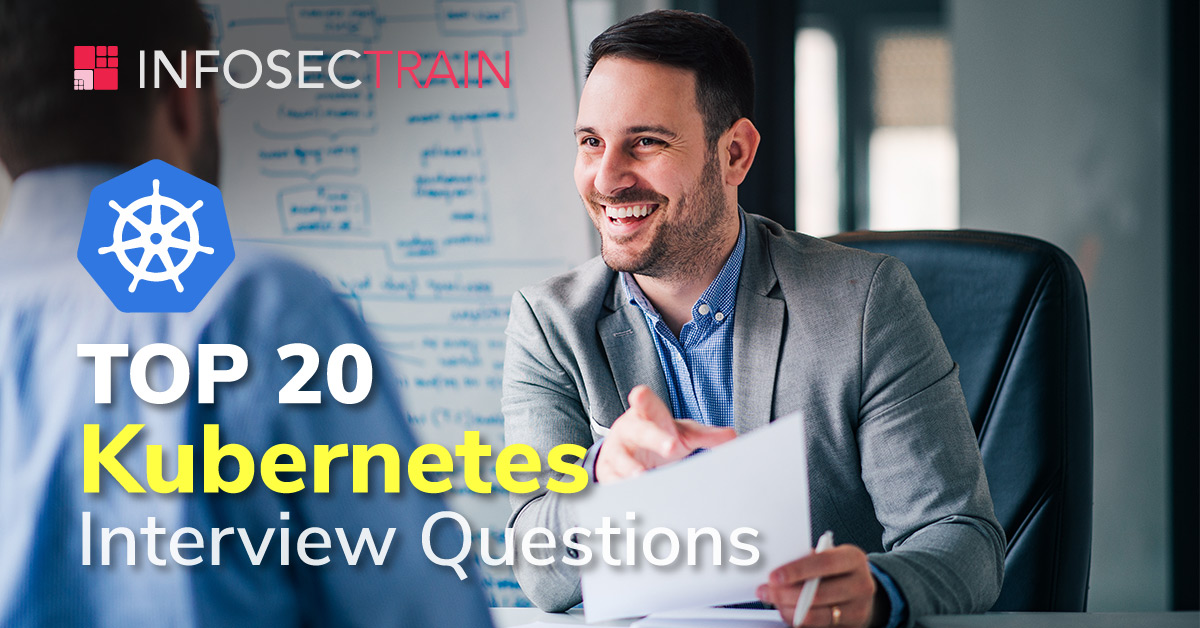Top 20 Kubernetes Interview Questions
Preparing for the Kubernetes interview? Here we bring top 20 Kubernetes interview questions with answers to help you prepare and crack the interview.

The introduction of Docker and other containers brought a revolution in application development. According to Cloud Native Computing Foundation Survey 2019, almost 84% of companies reported using containers in production. And, the majority of these companies, i.e., almost 78%, are presently using Kubernetes. Furthermore, the application container technologies market is expected to reach a total value of almost $4.3 billion by 2022.
With the rising popularity of Kubernetes, it is crucial to notice the possibilities of a promising career in the Kubernetes Landscape. Therefore, you should have a basic impression of Kubernetes interview questions that can help you showcase your understanding of Kubernetes to potential employers. You can find almost every frequently asked Kubernetes question in the following discussion.
Enroll Now:
Basic Kubernetes Interview Questions and Answers
- What is Kubernetes?
Kubernetes is Google’s open-source container orchestration tool that can help in container deployment, container scaling and descaling, and load balancing.
- What is the relation between Kubernetes and Docker?
Docker is capable of supporting container lifecycle management, and the Docker image provides the basis for runtime containers. Basically, Docker helps you build containers, and Kubernetes helps in ensuring communication between them.
- Define container orchestration?
Assume a case in which you have 3-4 microservices for a specific application. Now, each microservice would be in a different container, thereby losing the ability to communicate with each other. Container orchestration helps in coordinating the work of all containers to address the requirements of a particular server.
- How can Kubernetes simplify containerized deployment?
General applications comprise a cluster of containers that run across multiple hosts. Kubernetes is cloud-independent and could run on any public or private cloud service platform. It can help in load balancing, scaling, and monitoring of containers, thereby simplifying containerized deployment.
- What are the important components in Kubernetes architecture?
The two most important components in the Kubernetes architecture are the worker node and the master node. The master node and the worker node have their own individual components.
- Define a node in Kubernetes.
The node is a representation of a single machine in the cluster, thereby becoming the smallest fundamental unit of computing hardware. A node could either be a virtual machine or a physical machine in a data center.
- What are the processes that the Kubernetes Master Node runs?
The master node in Kubernetes runs the Kube-API server process and helps in scalability and deployment of additional instances.
- Define a pod in Kubernetes.
A pod in Kubernetes is a high-level structure wrapping up one or more containers because Kubernetes cannot run containers directly. Containers in a pod share similar local networks and resources, thereby allowing easy communication between them while remaining isolated.
- Define a cluster of containers in Kubernetes.
The cluster of containers is a set of nodes. Clusters are responsible for starting certain routes for enabling containers on the nodes to communicate with each other.
- What are the benefits of Kubernetes?
Kubernetes simplifies container management and improves responsiveness to customer demands through faster and predictable deployment. Users can avail the benefits of automatic rollback, horizontal scaling, and automated scheduling and auto-healing functionalities with Kubernetes.
- What are the components of a Kubernetes Master?
The Kubernetes Master contains the API server, the etcd components, the Scheduler, and the controller manager. These components support the operations and management of Kubernetes cluster.
- What is load balancing on Kubernetes?
Load balancing in Kubernetes is highly essential for exposing services. Users can find two types of load balancing in the case of Kubernetes, such as internal load balancing and external load balancing. Internal load balancing helps in automatic balancing of loads and allocation of pods with the desired configuration. External load balancing helps in directing traffic from external loads to backend pods.
- What is node affinity and pod affinity?
Node affinity helps in ensuring the hosting of pods on specific nodes. On the other hand, pod affinity helps in ensuring that two pods could be co-located on a single node.
- How can you start a rollback for an application?
The Rollback and rolling updates feature in Kubernetes is in-built with the Deployment object. If the existing state of a Deployment is unstable due to configuration or application code, then you can Rollback to earlier Deployment version. With every rollback, you can update the version of the Deployment.
- What are init containers?
You can find many containers in a Kubernetes pod, and init container is the first container that is executed before running other containers in the pod.
- What is the role of Namespace in Kubernetes?
Namespaces are ideal for distribution of cluster resources among multiple users in Kubernetes. Namespaces are specifically tailored for environments that involve multiple users spread across different projects or teams. In addition, they can also provide reliable insights into the scope of resources.
- What are the different controller managers in Kubernetes?
The common types of controller managers on Kubernetes running on the master node include the service accounts controller, token controller, endpoints controller, replication controller, node controller, and namespace controller.
- What is the role of etcd in Kubernetes architecture?
Etcd serves as a distributed key-value store for Kubernetes data, including configuration data and metadata. It helps the nodes in Kubernetes clusters for reading and writing data.
- What is Kube-proxy?
Kube-proxy is a load balancer implementation and serves a network proxy that supports service abstraction and other networking operations.
- What is Kubectl?
Kubectl is the command-line interface (CLI) that helps in running commands for Kubernetes clusters. It is a vital tool for controlling the Kubernetes cluster manager through various create and manage commands.
Conclusion
So, by going through above questions you can gain a basic impression of the type of frequently asked Kubernetes interview questions you can expect in the interview. Apart from the Kubernetes interview questions mentioned above, you can find a wide array of sources for detailed interview questions and answers. You can use such sources for gaining a detailed understanding of every Kubernetes interview question.
In addition, you should also gain in-depth expertise through Kubernetes training courses and hands-on practice. As you develop your skills and knowledge in Kubernetes, you can discover easier approaches to solve the toughest Kubernetes interview questions. Now is the right time to start your preparations for a promising career in Kubernetes – Make the most of it!
Preparing for a Kubernetes certification to add a credential in your resume? Check out our training for the Certified Kubernetes Administrator and Certified Kubernetes Application Developer certifications that will prepare you to pass the certification exams.








 1800-843-7890 (India)
1800-843-7890 (India)